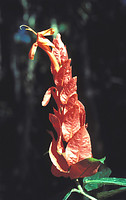Ruellia
Erin TrippIntroduction
Ruellia is a large genus of ca. 300 species. Mexico and Brazil are centers of diversity, but the genus is common elsewhere throughout the neotropics, Madagascar, mainland Africa. A few species also occur in southeast Asia, Australia, and temperate regions of North America and South America.
Recent molecular work (E. Tripp, MS in prep.) suggests Ruellia is probably monophyletic, but early diverging lineages are poorly resolved, and a small number of related genera will need to be transferred to Ruellia. Floral morphology is diverse within Ruellia. Putatitve pollination syndromes (e.g. bee, hummingbird, bat, hawkmoth) have evolved multiple times suggesting that pollinators have surely played an important role in the overall diversification of the genus. Pollen morphology (3-porate, spheroidal, coarsely reticulate) represents perhaps the best-known synapomorphy for the genus. Also, a haploid chromosome count of x = 17 has been found for nearly all Ruellia species to date.
Species of Ruellia can be found in a wide variety of habitats including understory rainforest, desert, swamp, tropical montane, and temperate grassland environments. Most are herbaceous but some are shrubs, small trees, or lianas. A majority of Ruellia species produce cleistogamous flowers in addition to open flowers. Ruellia seeds, like other Ruellieae, are covered by hygroscopic trichomes that become mucilaginous when wet. These traits aid in successful reproduction and dispersal, and probably help explain the widespread distribution of the genus. Several species of Ruellia are ornamentals, and others have been noted for their local, medicinal uses.
References
Daniel, T.F. & T.I. Chuang. 1993. Chromosome numbers of New World Acanthaceae. Syst. Bot. 18: 283-289.
Ezcurra, C. 1993. Systematics of Ruellia (Acanthaceae) in southern South America. Ann. Mo. Bot. Gard. 80: 787-845.
Grant, W.F. 1955. A cytogenetic study of Acanthaceae of Thailand. Brittonia. 8: 121-149.
McDade, L.A. and E.A. Tripp. Synopsis of Costa Rican Ruellia L. (Acanthaceae): New species, taxonomic concepts, a country record, range extensions, and identification aids to the 22 species known from the country. Brittonia, in rev.
Title Illustrations

| Scientific Name | Ruellia bourgaei Hemsl. |
|---|---|
| Location | Ixtlahuac?n del R?o, Jalisco, Mexico |
| Specimen Condition | Live Specimen |
| Identified By | E. Tripp |
| Life Cycle Stage | Flowering |
| Body Part | Flower and Habit |
| Collection | Ruellia bourgaei Hemsl. |
| Collector | P.C. Reyes |
| Copyright | © 2001 |
| Scientific Name | Ruellia affinis Lindau |
|---|---|
| Location | Duke Greenhouses |
| Reference | Duke Greenhouses |
| Specimen Condition | Live Specimen |
| Copyright |
© 2006

|
| Scientific Name | Ruellia pittieri Lindau |
|---|---|
| Location | Panama |
| Specimen Condition | Live Specimen |
| Collector | John L. Clark |
| Copyright | © 2003 John L. Clark |
About This Page

Duke University, Durham, North Carolina, USA
Correspondence regarding this page should be directed to Erin Tripp at
Page copyright © 2006
- First online 13 November 2006
- Content changed 13 November 2006
Citing this page:
Tripp, Erin. 2006. Ruellia. Version 13 November 2006 (under construction). http://tolweb.org/Ruellia/65583/2006.11.13 in The Tree of Life Web Project, http://tolweb.org/














 Go to quick links
Go to quick search
Go to navigation for this section of the ToL site
Go to detailed links for the ToL site
Go to quick links
Go to quick search
Go to navigation for this section of the ToL site
Go to detailed links for the ToL site